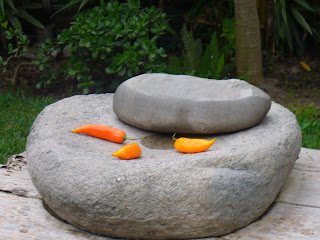Yesterday Diego, Jacho, and I had been feeling the need to get out of the city for a bit, so we slept in on Sunday -after two consecutive nights of staying up into the predawn hours (Friday just because, and Saturday at a birthday celebration)- and then headed out of Lima toward Pachácamac.
Pachacámac is the site of an Inca temple complex that once housed an oracle revered since pre-Inca times. There is also a small town nearby, also called Pachacámac, which is a quiet little place.
Pachacámac does have some agriculture, but its main attraction for outsiders are the restaurantes campestres -"country restaurants"- on the outskirts of town. These are establishments that specialize in serving foods that generally can't be cooked at home, such as spit-roasted meats, and foods cooked over wood fires, served outdoors. They often include games and playgrounds for the kids to encourage families to stay a while.
 |
| Community chess lessons in downtown Pachacámac |
Pachacámac does have some agriculture, but its main attraction for outsiders are the restaurantes campestres -"country restaurants"- on the outskirts of town. These are establishments that specialize in serving foods that generally can't be cooked at home, such as spit-roasted meats, and foods cooked over wood fires, served outdoors. They often include games and playgrounds for the kids to encourage families to stay a while.
We found our way to La Casa de Don Cucho, the establishment owned and run by restauranteur and TV cooking personality Luis "Cucho" La Rosa.
 |
| Cucho La Rosa |
The restaurant occupies the grounds of the main house of the former Casa Blanca hacienda, and is filled with antiques and knicknacks that La Rosa or the previous owners gathered over the years.
One very notable feature is the sizable collection of old batanes distributed throughout the grounds.
A batán is a grinding stone, composed of a flat -well, actually slightly concave- mortar and a wide, basically bean-shaped pestle, that is used with both hands, in a rocking motion, to grind foods.
They are an ancient tool, and still very much in use throughout Peru. In fact, many people who have access to modern electric kitchen aids still prefer the textures and flavours of sauces produced on a batán.
One food style that has come into fashion in recent years is meats cooked al cilindro. Basically, it is meat that is suspended inside a steel drum that has been converted into an oven/smoker, with embers being placed in the bottom.
As I hand't yet tried any dishes cooked in this fashion, we naturally decided that that the pork al cilindro was one the dishes we had to order.
We began our meal with a shared plate of anticuchos -seasoned, grilled skewers of beef heart.
 |
| Anticuchos |
 |
| Chupe de camarones |
And, being in the watershed of the Lurín river, which is known for the
quality of its crayfish, we opted for accompanying those with a shared
bowl of crayfish stew - chupe de camarones.
 |
| Chancho al cilindro |
We followed up by sharing the chancho al cilindro, and some arroz con pato - cilantro-laced rice and duck.
And we finished with a dessert of two puddings: purple corn-based mazamorra morada, and arroz con leche sweet rice pudding
La
Casa de Don Cucho is a vast place, easily seating over a hundred tables
at one time. However, it is run with industrial effiency, and the
service is prompt, courteous, and -most amazingly- accurate. They seem
able to get dozens and dozens of still-hot dishes out to diners spread
throughout ten or eleven covered dining "rooms" with hardly any errors
or delays.
We very much enjoyed our time there, as well as the food, which is well prepared, and comes in very generous portions -prefect for sharing. In fact, we are planning on recruiting the rest of the family for a return outing next weekend.












2 comments:
Que rico parece la comida y que lindo sitio ademas. Good find! So sorry I missed it!
-Liz
You and the kids would've liked it.
Post a Comment